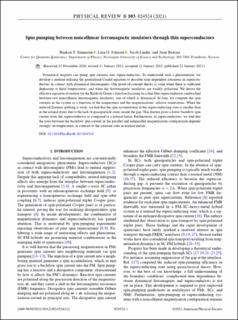| dc.contributor.author | Simensen, Haakon Thømt | |
| dc.contributor.author | Johnsen, Lina G. | |
| dc.contributor.author | Linder, Jacob | |
| dc.contributor.author | Brataas, Arne | |
| dc.date.accessioned | 2022-03-02T09:47:21Z | |
| dc.date.available | 2022-03-02T09:47:21Z | |
| dc.date.created | 2021-01-22T17:13:44Z | |
| dc.date.issued | 2021 | |
| dc.identifier.citation | Physical review B (PRB). 2021, 103 (2), . | en_US |
| dc.identifier.issn | 2469-9950 | |
| dc.identifier.uri | https://hdl.handle.net/11250/2982361 | |
| dc.description.abstract | Dynamical magnets can pump spin currents into superconductors. To understand such a phenomenon, we develop a method utilizing the generalized Usadel equation to describe time-dependent situations in superconductors in contact with dynamical ferromagnets. Our proof-of-concept theory is valid when there is sufficient dephasing at finite temperatures, and when the ferromagnetic insulators are weakly polarized. We derive the effective equation of motion for the Keldysh Green's function focusing on a thin film superconductor sandwiched between two noncollinear ferromagnetic insulators, one of which is dynamical. In turn, we compute the spin currents in the system as a function of the temperature and the magnetizations' relative orientations. When the induced Zeeman splitting is weak, we find that the spin accumulation in the superconducting state is smaller than in the normal states due to the lack of quasiparticle states inside the gap. This feature gives a lower backflow spin current from the superconductor as compared to a normal metal. Furthermore, in superconductors, we find that the ratio between the backflow spin current in the parallel and antiparallel magnetization configuration depends strongly on temperature, in contrast to the constant ratio in normal metals. | en_US |
| dc.language.iso | eng | en_US |
| dc.publisher | American Physical Society | en_US |
| dc.title | Spin pumping between noncollinear ferromagnetic insulators through thin superconductors | en_US |
| dc.type | Peer reviewed | en_US |
| dc.type | Journal article | en_US |
| dc.description.version | publishedVersion | en_US |
| dc.rights.holder | © 2021 American Physical Society | en_US |
| dc.source.pagenumber | 12 | en_US |
| dc.source.volume | 103 | en_US |
| dc.source.journal | Physical review B (PRB) | en_US |
| dc.source.issue | 2 | en_US |
| dc.identifier.doi | 10.1103/PhysRevB.103.024524 | |
| dc.identifier.cristin | 1877458 | |
| dc.relation.project | Norges forskningsråd: 262633 | en_US |
| cristin.ispublished | true | |
| cristin.fulltext | postprint | |
| cristin.qualitycode | 2 | |
